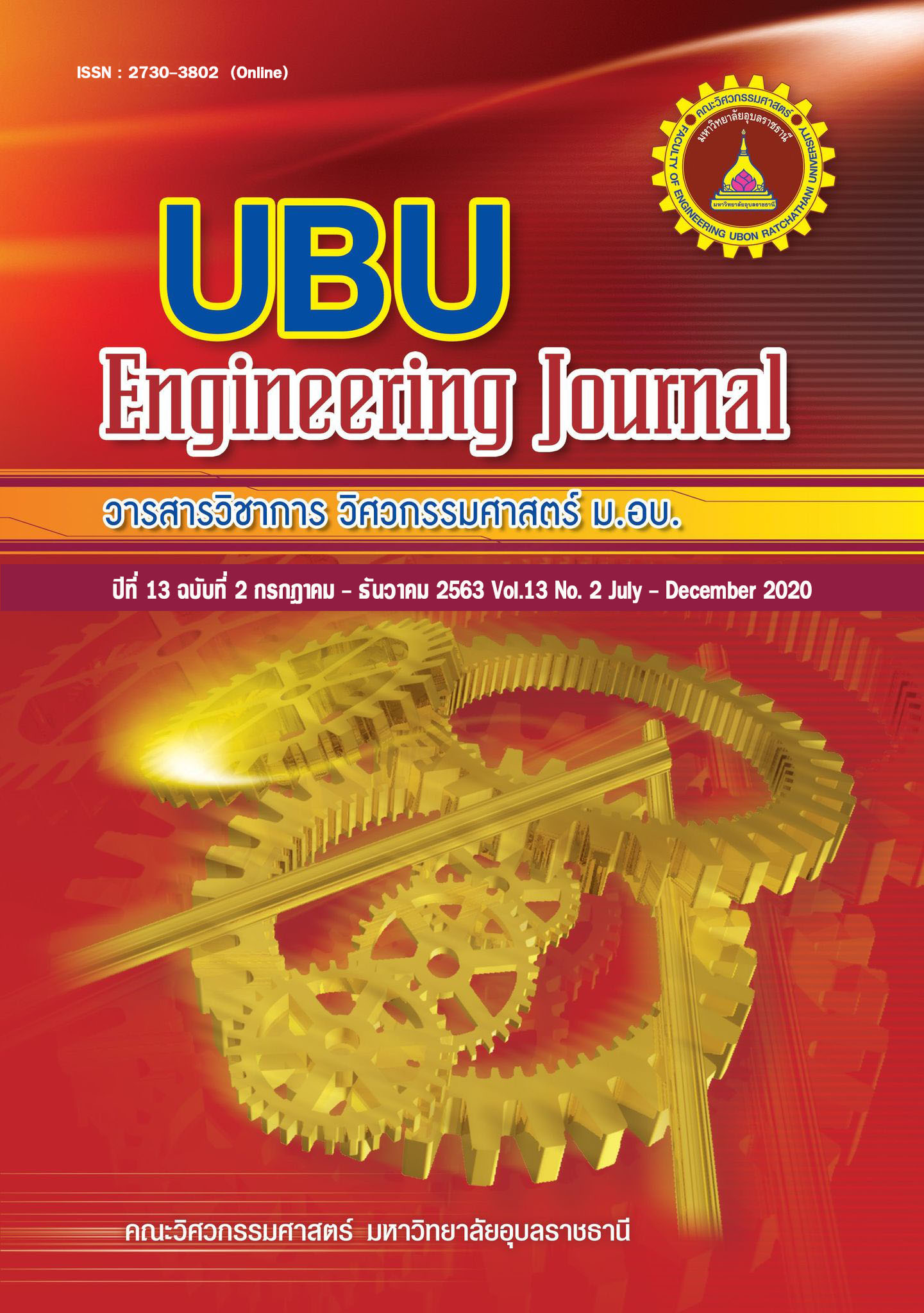ผลของขนาดอนุภาคนาโนซิลิกา ต่อความทนทานสารละลายซัลเฟตและกรด และกำลังยึดเหนี่ยวของซีเมนต์มอร์ต้าร์ผสมนาโนซิลิกา
Main Article Content
บทคัดย่อ
งานวิจัยนี้นำเสนอค่าความทนทานต่อสารละลายซัลเฟตและกรด กับกำลังยึดเหนี่ยวและผลของแรงกระทำคงค้างต่อกำลังยึดเหนี่ยวของเหล็กข้ออ้อยในคอนกรีตที่ยึดประสานกันด้วยซีเมนต์มอร์ต้าร์ผสมนาโนซิลิกาที่มีขนาดอนุภาค 12 20 และ 40 นาโนเมตร ทดสอบความทนทานต่อสารละลายซัลเฟตและกรด ทั้งทางด้านกำลังอัด การขยายตัว และการสูญเสียน้ำหนัก รวมทั้งทดสอบค่ากำลังยึดเหนี่ยวและทดสอบผลของแรงกระทำคงค้างของซีเมนต์มอร์ต้าร์ผสมนาโนซิลิกาหลากหลายขนาด จากผลการทดสอบพบว่าขนาดอนุภาคของนาโนซิลิกาส่งผลต่อความทนทานต่อสารละลายซัลเฟตและกรด นาโนซิลิกาที่มีขนาดอนุภาค 40 นาโนเมตร ให้ค่ากำลังอัดของซีเมนต์มอร์ต้าร์ที่สูงสุด ในขณะที่ค่าการขยายตัว และการสูญเสียน้ำหนักมีค่าน้อยที่สุดเมื่อเปรียบเทียบกับซีเมนต์มอร์ต้าร์ที่มีส่วนผสมปูนซีเมนต์ปอร์ตแลนด์ประเภทที่ 1 และ 5 ในส่วนผลของกำลังยึดเหนี่ยวและผลของแรงกระทำคงค้างของเหล็กข้ออ้อยในคอนกรีตที่ยึดประสานด้วยซีเมนต์มอร์ต้าร์ผสมนาโนซิลิกา ผลการทดสอบพบว่าขนาดอนุภาคของนาโนซิลิกายังส่งผลต่อค่ากำลังยึดเหนี่ยวและพฤติกรรมการคืบด้วยเช่นกัน ซีเมนต์มอร์ต้าร์ที่ผสมนาโน ซิลิกาขนาดอนุภาค 40 นาโนเมตร มีค่ากำลังยึดเหนี่ยวและแรงกระทำคงค้างที่สูงกว่านาโนซิลิกาขนาดอนุภาค 12 และ 20 นาโนเมตร รวมทั้งวัสดุยึดประสานอีพ๊อกซี่
Article Details
References
mechanism of sulfate attack on concrete under freeze-thaw cycles. Journal of Wuhan University of Technology-Materials Science. 2013; 28(6): 1172-1176.
[2] Chindaprasert P, Jaturapitakkul C. Cement pozzolan and concrete. Thailand Concrete Association. 2008; 11:235-340.
[3] คุณาพจน์ วงษ์คำ, เชิดศักดิ์ สุขศิริพัฒนพงศ์, เสริมศักดิ์ ติยะแสงทอง, จักษดา ธำรงวุฒิ, ชยกฤต เพชรช่วย. กำลังอัดและโครงสร้างจุลภาคของดินลูกรัง-กากกาแฟปรับปรุงด้วยเถ้าลอยจีโอโพลีเมอร์. วารสารวิชาการ วิศวกรรมศาสตร์ ม.อบ. 2561; 11(2): 65-73.
[4] Ye Q, Zhang Z, Kong D, Chen R. Influence of nano-SiO2 addition on properties of hardened cement paste as compared with silica fume. Construction and Building Materials. 2007; 21: 539-545.
[5] Veronica S, Alisson C, Noan T, Eduardo S, Fernanda S, Sergio N. Mechanical and microstructural characterization of geopolymer concrete subjected to fatigue. Journal of Materials Research and Technology. 2018; 7(4): 566-570.
[6] Saccani A, Magnaghi, V. Durability of epoxy resin-based materials for the repair of damaged cementitious composites. Cement and Concrete Research, 1999; 29: 95-98.
[7] Li H, Zhang M.H, Ou J.P. A study on mechanical and pressure-sensitive properties of cement-mortar with nanophase materials. Cement and Concrete Research. 2004; 34: 435-438.
[8] Zhang M.H, Li H, Ou J.P. Flexural fatigue performance of concrete containing nano-particles for pavement. International Journal of Fatigue. 2007; 29: 1292-1301.
[9] Jo B.W, Kim C.H, Tae G.H, Park J.B. Characteristics of cement mortar with nano-SiO2 particles. Construction and Building Materials. 2007; 21: 1351-1355.
[10] Haruehansapong S, Pulngern T, Chucheepskul S. Effect of the partical size of nanosilica on the compressive strength and the optimum replacement content of cement mortar containing nano-SiO2. Construction and Building Materials. 2014; 50: 471-477.
[11] Haruehansapong S, Pulngern T, Chucheepskul S. Effect of nanosilica partical size on the water permeability, abrasion resistance drying shrinkage, and repair work properties of cement mortar containing nano-SiO2. Advance in Materials Science and Engineering. 2017; 1-11.
[12] Jaison J, Ahmed B, Yen S.C, Alain D, Michael K.D. Review on nanoparticles and nanostructured materials: history, sources, toxicity and regulations. Beilstein Journal of Nanotechnology. 2018; 9: 1050-1074.
[13] Paratibha A, Rahul P.S, Yogesh A, Raja R.H. Use of nano-silica in cement based materials-a review. Cogent Engineering. 2015; 2(1): 1-11.
[14] Iqbal G, Ali A.J, Maan S.H. Sulfate and chloride resistance of nanosilica and microsilica contained self-consolidation concretes. Kufa Journal of Engineering. 2018; 9(4): 23-44.
[15] Nader G, Iani B, Meysam. Sulfate resistance of nanosilica and microsilica contained mortars. Aci Materials Journal. 2016; 113(4): 459-469.
[16] Vital A, Klotz U, Graulet T, Mueller R, Kammler H.K, Pratsinis S.E. Synthesis of spherical, non-aggregated silica nanoparticle. NATO Advanced Research Workshop on Nanostructured Materials and Coatings. 2002; 102: 203-210.
[17] วิเชียร ชาลี, กิรติกร เจริญพร้อม. การต้านทานการกัดกร่อนเนื่องจากซัลเฟตของจีโอพอลิเมอร์คอนกรีตจากเถ้าถ่านหิน วารสารและวิจัยพัฒนา มจธ. 2555; 35(2): 157-171.
[18] ASTM C1437. Standard Test Method for Flow of Hydraulic Cement Mortar. West Conshohocken: ASTM International; 2007.
[19] ASTM C109. Standard Test Method for Compressive Strength of Hydraulic Cement Mortar (Using 2 in. or [50 mm.] Cube Specimens). West Conshohocken: ASTM International; 1997.
[20] ASTM C490. Standard Practice for Use of Apparatus for the Determination of Length Change of Hardened Cement Paste, Mortar and Concrete. West Conshohocken: ASTM International; 2001.
[21] ASTM C490. Standard Test Method for Weight Loss (Mass Loss) of Sheet Steel During Immersion in Sulfuric Acid Solution. West Conshohocken: ASTM International; 2016.
[22] ASTM C234. Standard Test Method of Comparing Concrete on the Basic of Bond Developed with Reinforcing Steel. West Conshohocken: ASTM International; 1997.
[23] ASTM D2290. Standard Test Method for Tensile, Compressive, and Flexural Creep and Creep-Rupture of Plastics. West Conshohocken: ASTM International; 2010.
[24] ธีรติ ศรีจันทร์, บุรฉัตร ฉัตรวีระ, พงษ์ศักดิ์ โชคทวีกาญจน์, สมนึก ตั้งเติมสิริกุล. การศึกษาผลของการบ่มต่อกำลังอัดของคอนกรีตที่ใช้ชนิดของปูนซีเมนต์และวัสดุประสานร่วมต่างกัน. วารสารและวิจัยพัฒนา มจธ. 2554; 34(4): 383-394.
